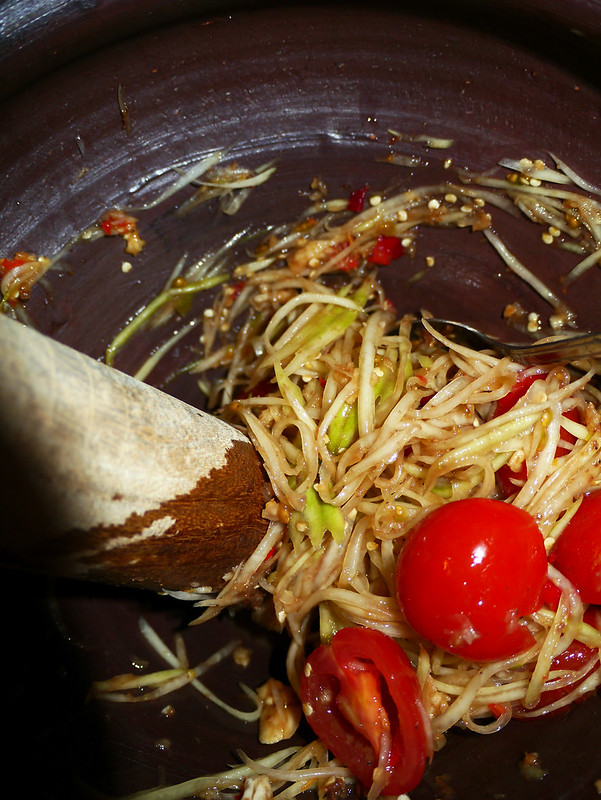
“Tum mark hoong” (Lao spicy green papaya salad) is a refreshing salad full of intense flavours: spicy, sour, salty, sweet and umami/savoury. It is addictive and delicious, perfect as a side dish or eaten with “khao neow” (Lao sticky rice), “ping gai” (grilled chicken) and leafy vegetables, such as cabbage, lettuce and water spinach.
The green papaya salad is a very popular dish in Southeast Asia and its popularity is growing across the world. There are as many variations to the green papaya salad recipe as there are its fans. To the Lao people, it is known as “tum mark hoong” (which translates to “pounded papaya”). It is one of the signature dishes of Laos. 1
In Lao, this dish is also known as “tum som” (which translates to “pounded sour”). However, tum som is a collective term that refers to all “pounded sour” salad dishes, including green papaya, snake bean, carrot, cucumber and vermicelli. In Thai, the collective term for pounded sour salads is som tum (“sour pounded”) instead of tum som.
There is a distinction between the Lao and Thai recipes. The addition of padaek/padek (traditional fermented Lao fish sauce) in the Lao recipe gives tum mark hoong a distinctive umami flavour, aroma and colour.
The following recipe is based on my many years of eating tum mark hoong from many different cooks (Lao and non-Lao) and even though I did not use padaek (I need to ask my mum for some and try to make my own), I am still pretty happy to call it a Lao recipe.
Essentially, the recipe is quite traditional. Although, sometimes I do wonder what a traditional tum mark hoong recipe really is? Because some cooks add msg, garlic and palm sugar, for example and some don’t. Either way, many tum mark hoong makers would agree that you can vary and mix up the recipe as you please and adjust the ingredients, flavours and intensity to suit your own palate.
That’s enough jibba jabba. Here’s the recipe for my Lao spicy green papaya salad, aka tum mark hoong. Please enjoy with care and moderation. Bon appetit and sern sap! bigsmile

Here are some of the ingredients that you’ll need to make tum mark hoong. All of these ingredients should be available at your friendly Asian grocery store, although the green papaya is seasonal, so you might have a challenge finding it. Pork crackle (at the back, and only half of the packet made it back home) make moreish accompaniments with the salad. Although not included in the recipe, green mangoes are difficult to find so I included one in the photo anyway. The chilies at the front (labeled “Thai chilies”) might look small, but believe me, they are potent!
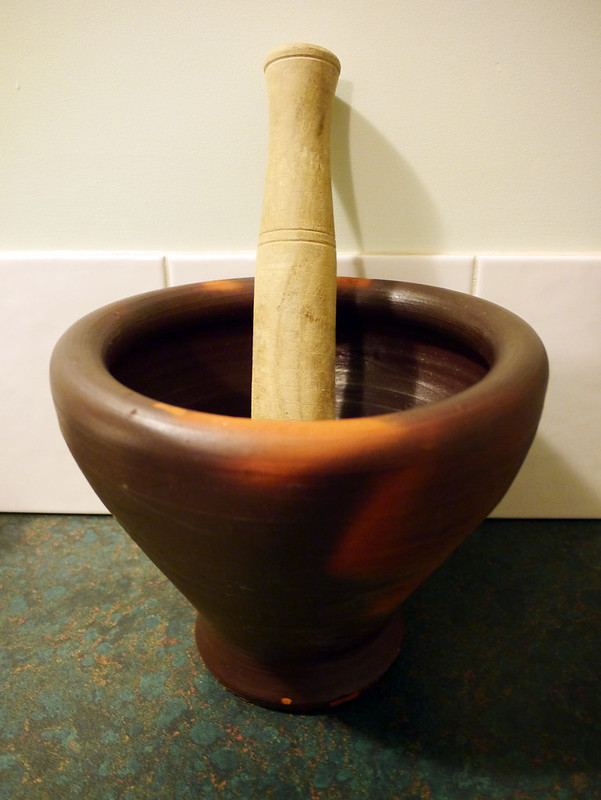
My two most favourite kitchen-hands/assistants: “Kok” and “Sark” (Lao mortar and pestle). These two guys are awesome and the best help in the kitchen that I can ask for. I honestly don’t know what I’ll do without them.

Wash and prep your ingredients. Be sure to wash the green papaya thoroughly. After you’ve peeled the papaya and before shredding it, wash it again to remove as much of the sap as possible.
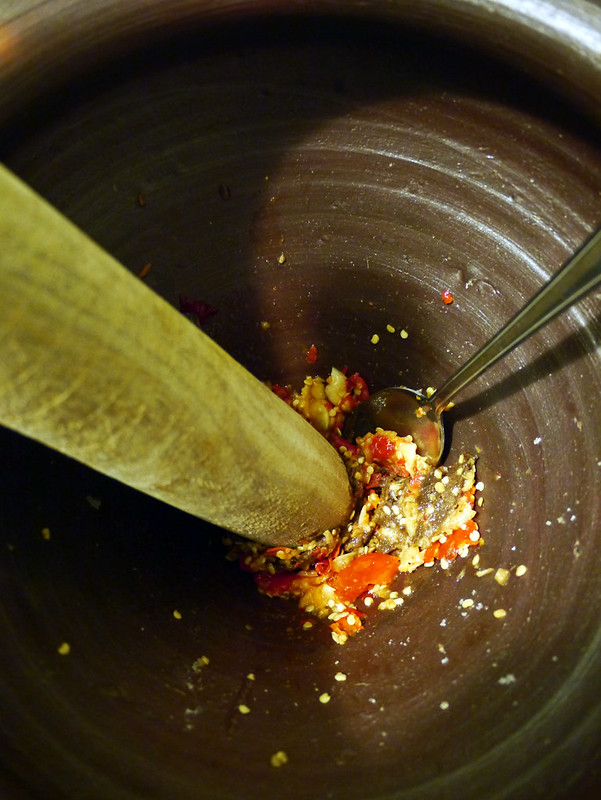
Pound the garlic, chilies, salt, sugar and shrimp paste with the mortar and pestle until they are roughly of the consistency above.
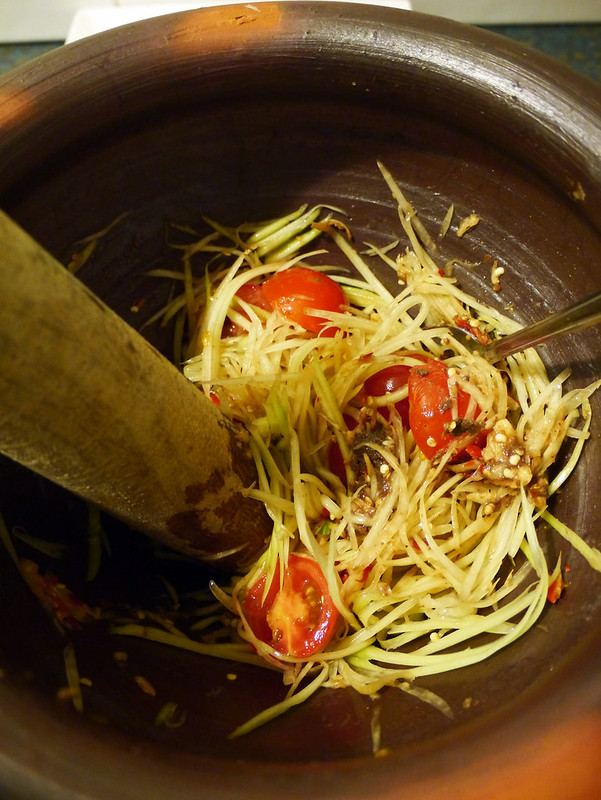
Add the shredded green papaya, halved cherry tomatoes and pound and turn them into the mixture with the pestle and a spoon. Don’t pound the cherry tomatoes too much because you want some of them to keep their shape and be plump and juicy. Good presentation is important in food enjoyment.
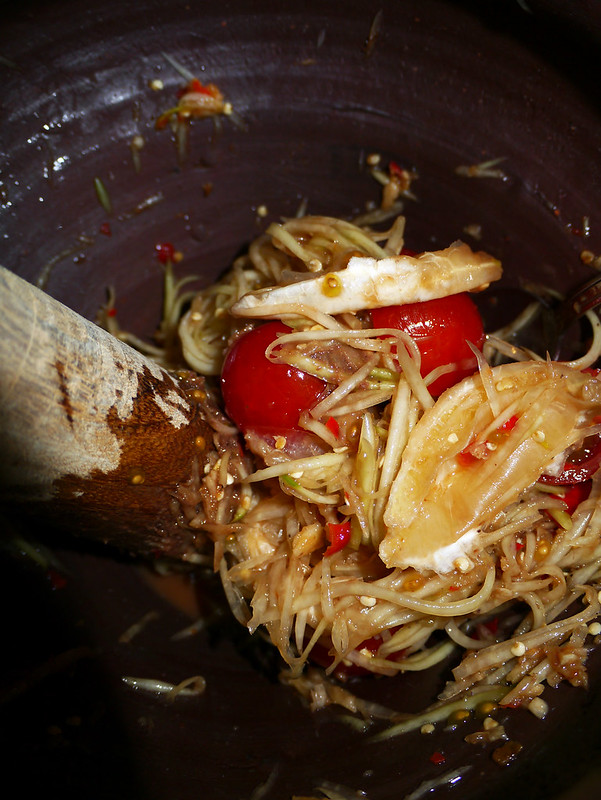
Add the fish sauce and squeeze in the lemon/lime juice. I like to peel the lemon flesh off its skin and add it into the salad. It is called tum som for a reason (som=sour), and the lemon flesh becomes so tasty and juicy to eat! I used my fingers to peel the lemon flesh but if you have guests watching, you might want to use a knife or spoon instead. Are you getting hungry yet?
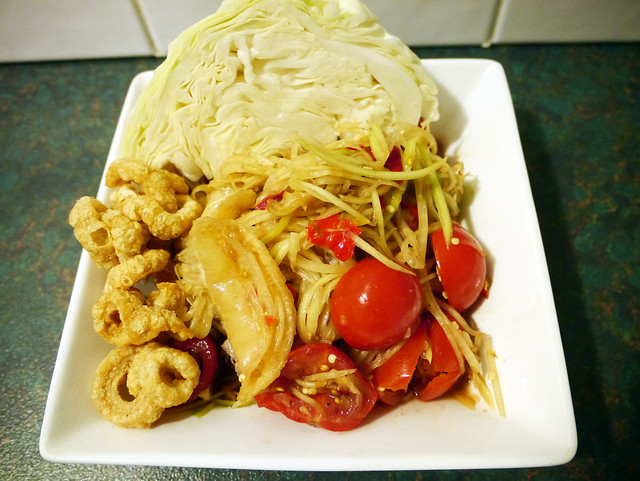
Voila! The finished ensemble. Lao spicy green papaya salad aka “tum mark hoong”. Served with a wedge of cabbage leaves and swirls of pork crackle. Also recommended as great accompaniments are grilled chicken and/or beef/fish jerky. Enjoy with sticky rice. Give it a try, I’m sure you’ll love it.
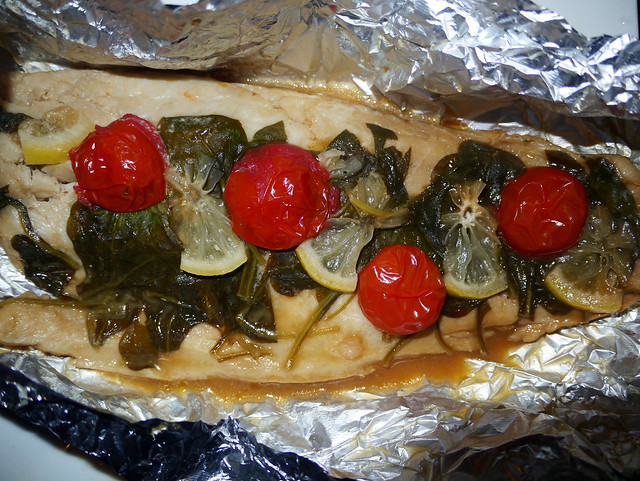
We ate the tum mark hoong with baked fish. Yes, it was very good too!
- 1 green papaya or papaw (you only need half for this recipe)
- 10 hot chilies (or as many as you like - you'll need at least 1)
- 6 cherry or grape tomatoes (halved)
- 2 cloves of garlic
- 1 lemon or lime
- 1 Tbsp of fish sauce
- 1 tsp of shrimp paste
- 1 tsp of salt
- 1 tsp of sugar
- Prep all of your ingredients before you start cooking. Wash and peel half of the green papaya. After you’ve peeled the papaya and before shredding it, wash it again to remove any excess sap. Shred/julienne half of the papaya with the miracle knife, or a cleaver/knife. Be very careful.
- Peel the garlic cloves, wash the chilies, slice the lemon/lime into wedges, halve the cherry tomatoes.
- Start by pounding the garlic, chilies, salt, sugar and shrimp paste with the mortar and pestle. It's good to have some texture in the mixture.
- Add a handful of the shredded papaya and halved cherry tomatoes into the mortar, and gently pound them into the mixture. Turn and fold the mixture with a spoon, at the same time pound them together with the pestle. Don’t pound the cherry tomatoes too much because you want some of them to keep their shape and still be plump and juicy.
- Add the remaining shredded papaya, fish sauce, and squeeze in the lemon/lime juice. Continue to pound and turn the mixture together. After squeezing out the lemon juice, I like to peel the lemon flesh off its skin and add it into the mix. You might want to use a knife or spoon to do this. Continue to pound and turn the mixture evenly together.
- Taste the salad and sauce, and adjust the flavour to suit your preference. What you're aiming for is a punchy balance of spicy, salty, sour, sweet and umami flavours!
- Transfer the salad mix into a bowl/plate and serve with sticky rice, grilled chicken/meat, pork crackle, a wedge of cabbage, lettuce or other salad greens. Enjoy!
You can also add 1 shredded carrot into the salad. This will provide a lovely orange contrast and sweet carrot flavour to the dish.
Other vegetables you can add are radish, snake/long beans, and Thai/kermit eggplants.
Recommended Items:

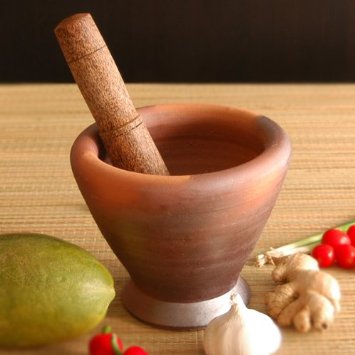
Did you know?
1. The hottest chili is Smokin Ed’s ‘Carolina Reaper’, grown by The PuckerButt Pepper Company (USA), which rates at an average of 1,569,300 Scoville Heat Units (SHU), according to tests conducted by Winthrop University in South Carolina, USA, throughout 2012. The Scoville Unit (SHU) scale is a method of quantifying a substance’s “spiciness”, through determining the concentration of the chemical compounds responsible for the sensation, which are named capsaicinoids. 2 To give an indication of the Carolina Reaper’s spiciness, a Jalapeno can score anything between 2,500 to 8,000 SHU on the scale. 3
2. There’s a difference between papaya and papaw (also spelt pawpaw). Papaya has an orange-red coloured flesh and yellow-orange coloured skin, with a sweet flavour. Papaw is a rounder and larger fruit, with distinct yellow flesh and pale orange skin, slightly more savoury in taste. 4
Notes:
- There are several variations to the Lao pronunciation and English spelling of tum mark hoong. In Laos, there are at least two main Lao accents that I know of; Vientiane and Luang Prabang. There are also other languages in Laos which further contribute to the different pronunciation and spelling of certain words. ↩
- Reference: http://www.guinnessworldrecords.com. ↩
- Reference: http://www.guinnessworldrecords.com. ↩
- Thus, from this description, it appears that the fruit that I used to make the tum mark hoong in the recipe above is actually a papaw! Reference: http://www.australianpapaya.com.au. ↩
Yumm! My favorite is actually tum mak tor. My mom’s version has no garlic since it can make it taste bland when we let it sit at parties or for later eating. Even though it’s definitely better fresh. Mhmmm.
Hi Diana,
Thanks for your comment. The first comment on the site. Awesome! Do you mean bean or snake bean (Vigna unguiculata subsp. sesquipedalis)? If so, yes I think it’s very good too. My mum adds padaek to her one and it tastes so good. Interesting what you said about garlic. I never knew that it does that. I enjoy having garlic in the recipe because it adds an extra sharpness and bite to the flavour which heightens the whole tum som experience. Next time, I will try and make tum som without garlic and taste the difference. I agree, freshly made tum som is the best. With ping gai or seen hang and khao neow or khao poon. Yum-o! Thanks for stopping by. Enjoy your holidays.
I love Lao’s salad! I haven’t tried the others but this one is one of my fav salads ever. The tangy, sweet, spicy sensations; it’s a party in my mouth!
Hi irene,
Thanks for your comment. I appreciate it. Laotians love salads of all sorts: green, meat, rice, you name it. Salads are usually quickly and freshly prepared and full of zest and flavour. This is a popular dish and one of my favourites. The thought of it is mouth-watering. Yes, it does taste like a party in the mouth. I am perplexed as to how your comment jumped up to #3? [scratches head and a little spooked]
Yummy Padaek, I like the sound of your tom sum… Peter and I really enjoy the Thai version… so now I will try and find some Lao fish sauce!
Hi Lizzy,
Yes, tum som and som tum are taking the world by storm with their delicious and refreshing flavours and ingredients. I love both versions of the salad and the fermented fish sauce really gives the Lao one a delicious character. It’s available at some Asian grocery stores or you can even make your own. Thanks Lizzy!
Looks great, I loved green papaya salad for years but I only found out a few months ago that it is lightly pounded together. I will have to try this soon when I get my hands on some green papaya.
Hi Elizabeth,
Thanks for your comment. I appreciate it. Yes, in Lao, spicy pounded salads are called tum som, literally “pounded sour”. The Lao mortar and pestle are indispensable tools in a Lao kitchen. The base ingredients for tum som including chili and garlic are pounded to a rough consistency and then the remaining ingredients including the tomatoes and green papaya are pounded and stirred through. It’s a simple art that is packed full of flavours. Asian grocers often have green papaya/pawpaw. You can also substitute it with other ingredients including snake beans, carrots, radishes and granny smith apples.